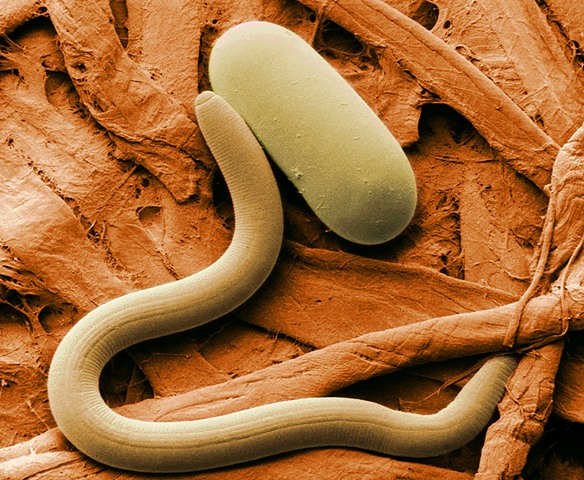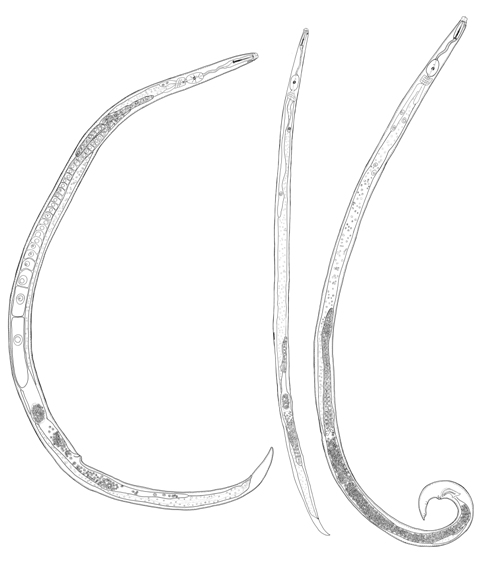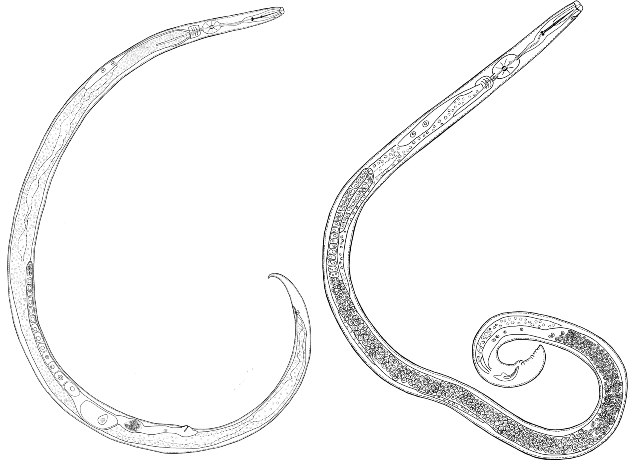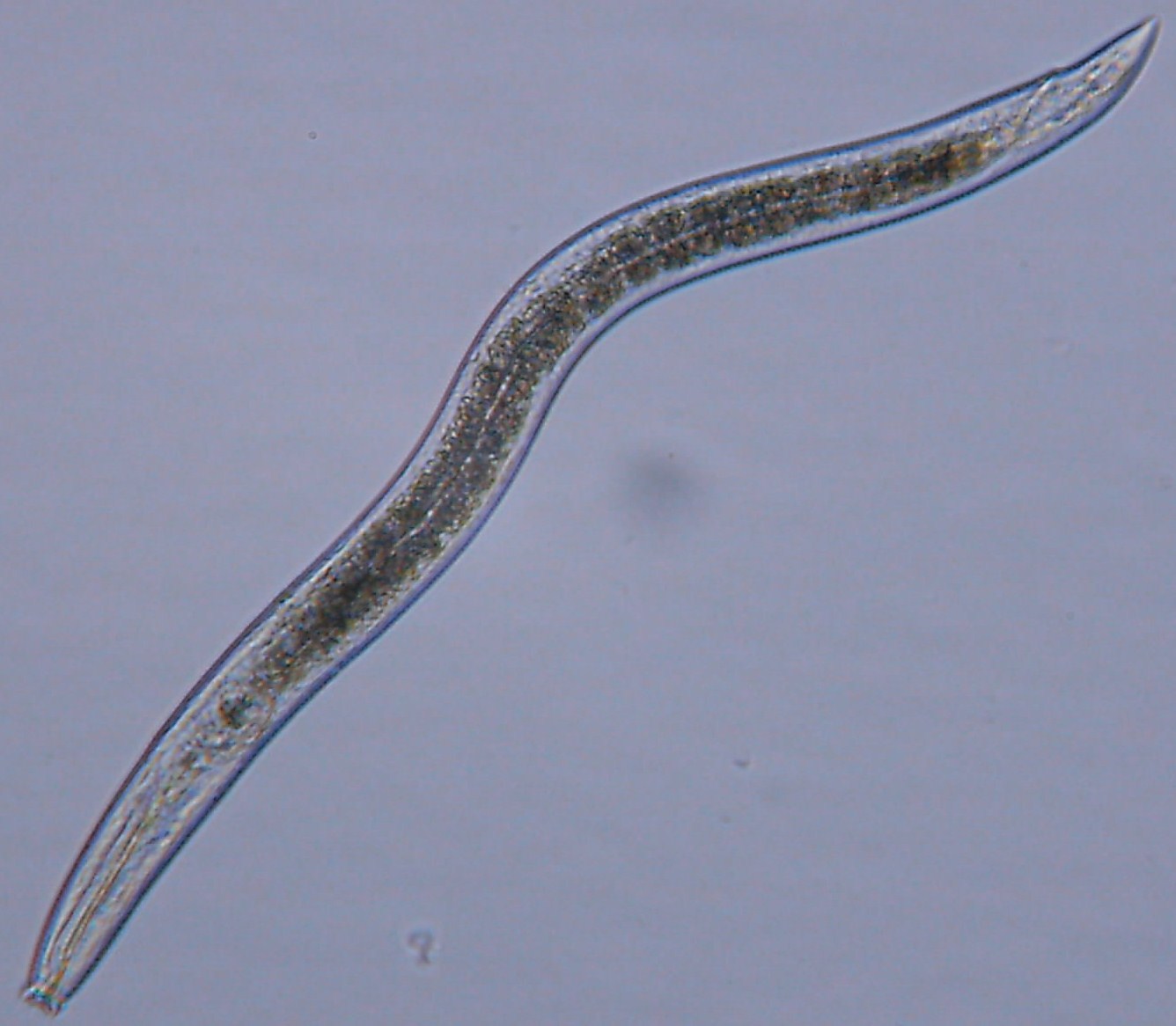Phylum Nematoda
Common name: round worms
Overview
Nematodes are a very diverse phylum of mostly small, white, translucent worms which are found in huge numbers in almost every habitat on earth. Nematodes range in size from 0.2 mm to 8 m long and 3 microns to 1 cm diameter. The largest nematodes are internal parasites; most encountered outside hosts are 1 to 5mm long. Nematodes are a well defined phylum quite unlike any other animal, but their evolutionary relationship to other phyla remains unclear: they have been thought related to rotifers, nematomorphs and other small phyla in a group known as aschelminths, but some evidence points to a relationship with tardigrades, insects and crustacea in a group known as ecdyzozoans.
Distribution and diversity
There are an estimated 1,000,000 species of round worms worldwide, of which only 2-5% have been formally described, and many more races, pathotypes and other sub-specific taxa. There are about 1000 named species in Australia.
Life cycle
Nematodes have a direct life cycle with four immature stages, often referred to as juveniles or larvae. Between each stage a new cuticle is grown underneath the old cuticle, which is then moulted and lost. Immature stages are mostly morphologically similar to the adult stage, but in some cases there are large differences. In other cases there are multiple life cycles, with one morphology and life cycle completed in one habitat and a different morphology and life cycle occurring in another habitat, with occasional switches between the two. Most species have both males and females in proportions varying from 50% or more males to cases where males are very rare or only found under certain conditions. A few species are parthenogenic, either mitotic or meiotic. Most species are oviparous, a few are viviparous. Life cycles vary in duration from less than two days to several years, but resting stages may lengthen this almost indefinitely. The resting stage may be any stage of the cycle: egg, one of the immature stages, or an adult before or after mating. Females can lay several million eggs throughout their adult life. Parasitic nematodes lay the most eggs; free-living nematodes rarely lay more than a few thousand eggs.
Feeding
Nematodes all feed on live organisms: there are no true detrivores. The exact foods of nematodes in nature are mostly unknown, and what is known is based on direct observations under artificial conditions in the laboratory, culturing studies, morphology of the mouthparts, and extrapolation from known taxa. Nematodes are mostly polyphagous to some extent, but are divided according to both the predominant type of food consumed and the way it is obtained. Slightly different divisions have been used for aquatic and terrestrial nematodes: the following is a unified system based on both.
1. Plant feeders: feed on or inside every different part of plants. Root feeders are most common, but leaf, stem and seed feeders are also found. Some species are damaging economic parasites which kill the host plant while others appear to have little effect, with all grades in between. A few species feed on marine and freshwater macroalgae.
2. Fungal feeders: feed on hyphal fungi in the soil, in cadavers, wood or bark
3. Microbial feeders: feed on single cell microbes, mostly bacteria. The many nematodes associated with decomposing vegetable matter and dung feed on the microbes rather than the vegetable matter or dung itself. This trophic group may feed by sucking cells from suspension, or scraping cells from substrates, either selectively or unselectively.
4. Algal feeders: feed on micro algae, mostly terrestrial. The nematodes feeding on macroalgae are classified with the plant feeders.
5. Predators: feed on other small organisms, including mites, insects, other nematodes (sometimes of the same species), and protists. Some predators use a large spear or tooth to pierce potential prey, then suck out the contents, while others have a large mouth with powerful jaws to crush prey.
6. Omnivores: feed on a range of foods, presumably depending on availability
7. Non-feeding stages
8. Animal parasites: feed on the internal or external body of larger animals, such as arthropods, annelids, and molluscs. There are many nematode parasites of vertebrates, but these are not included in this key.
Ecology
Nematodes are found in a huge diversity of environments including marine, freshwater and terrestrial habitats, including everywhere from deserts to Antarctica. Parasitic nematodes are significant pests of Australian agriculture, affecting cotton crops and vineyards. Many of the species which are free-living in the soil enhance nutrient cycling and are beneficial, acting as biological indicators of environmental health.

Soybean cyst nematode
Image credit: Agricultural Research Service, United States Department of Agriculture
Public Domain

Schistonchus sp. line drawing
Image credit: � Kerrie Davies
used with permission

Schistonchus sp. line drawing
Image credit: � Kerrie Davies
used with permission

Nematoda
Image credit: � Alejandro Velasco Castrillon
used with permission










